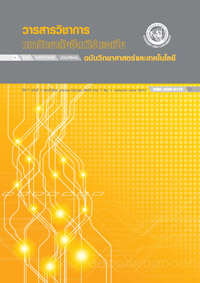A Development of Pyrolysis Oven for Wood Vinegar Production
คำสำคัญ:
wood vinegar, pyrolysis, oven, design of experiments, economic analysis, น้ำส้มควันไม้, ไพโรไลซิส, เตาอบ, การออกแบบการทดลอง, การวิเคราะห์เชิงเศรษฐศาสตร์บทคัดย่อ
This research was undertaken to develop a pyrolysis oven for the production of wood vinegar using charcoal residual as fuel. The oven was designed with an inside chamber for the heat to be evenly distributed throughout the oven and a lid covered the oven. The hollow space between the inner oven wall and the chamber wall was used for containing fuel, and the hollow space of the chamber was used for containing the pyrolyzing wood chips. The pyrolyzing chamber’s capacity for wood chips was 0.2 m3 and a chimney was attached to the burning chamber for smoother ventilation. An air cooled condensing system was used for the extraction process allowing for raw wood vinegar collection. The oven was made of refractory brick lining, rendered by refractory concrete with the pyrolyzing chamber made of metal sheets. In this research, a factorial design of experiments with 3 replicates and 5% significant level was developed. Objective was to study the influence of the kind and weight of pyrolyzing wood chips on the yield percent of the wood vinegar collected. Furthermore, it aimed to determine the optimal conditions for producing wood vinegar. Three kinds of pyrolyzing wood were used in this study namely Eucalyptus, Rubber wood and Acacia chips, and three levels of wood chip weights of 20, 40, and 60kg were selected for the experiment. Finally, the economic analysis of the wood vinegar production was performed. The results showed that the oven was economically attractive and it s payback period was short.
งานวิจัยนี้ได้พัฒนาเตาอบสำหรับผลิตน้ำส้มควันไม้โดยใช้เศษถ่านเป็นเชื้อเพลิง เตาอบนี้ได้ออกแบบให้มี ห้องอบซ้อนอยู่ภายในอีกชั้นหนึ่งเพื่อให้มีการกระจายความร้อนที่ดี โดยเตาอบจะมีฝาปิดอยู่ทางด้านบน ช่องว่าง ระหว่างผนังห้องอบด้านในและผนังเตาด้านนอกใช้สำหรับใส่เศษถ่านที่เป็นเชื้อเพลิง ส่วนห้องอบภายในนั้นใช้ สำหรับใส่ชิ้นไม้สำหรับอบโดยมีปริมาตรห้องอบ 0.2 m3 ใช้ปล่องควันหนึ่งปล่องในการระบายควันจากการเผาไหม้ เครื่องควบแน่นชนิดใช้อากาศระบายความร้อนถูกนำมาใช้ในการดักเก็บน้ำส้มควันไม้ ตัวเตาผลิตขึ้นจากอิฐทนไฟ ฉาบด้วยคอนกรีต ผนังห้องอบทำจากแผ่นเหล็ก ออกแบบการทดลองแบบซ้ำ 3 ครั้ง ที่ระดับนัยสำคัญ 5% เพื่อศึกษา อิทธิพลของชนิดและน้ำหนักของชิ้นไม้ที่มีผลต่อปริมาณน้ำส้มควันไม้ที่ได้เพื่อหาสภาวะที่เหมาะสมในการผลิต น้ำส้มควันไม้ ได้ทำการศึกษาไม้ 3 ชนิด ได้แก่ไม้ยูคาลิปตัส ไม้ยางพารา และไม้กระถิน โดยใช้ปริมาณที่ทำการ ทดลองคือ 20 kg, 40 kg และ 60 kg ตามลำดับ จากการวิเคราะห์เชิงเศรษฐศาสตร์พบว่ามีความคุ้มค่าในการ ลงทุนโดยใช้ระยะเวลาคืนทุนที่ต่ำ






